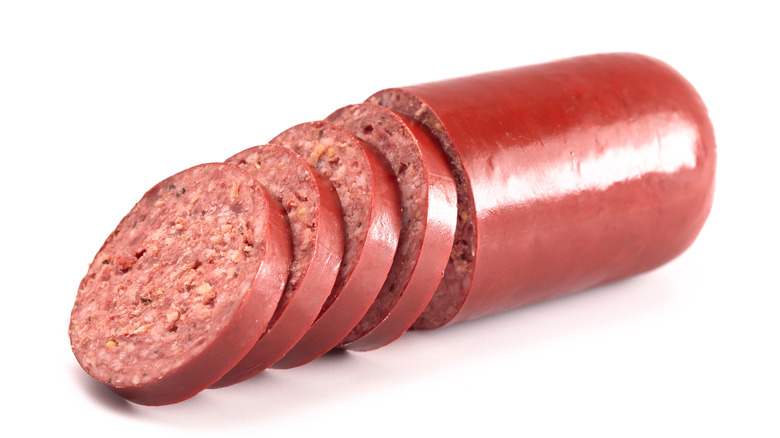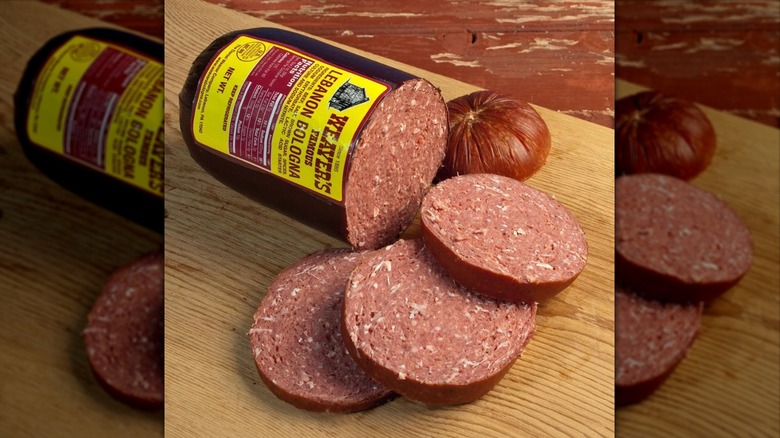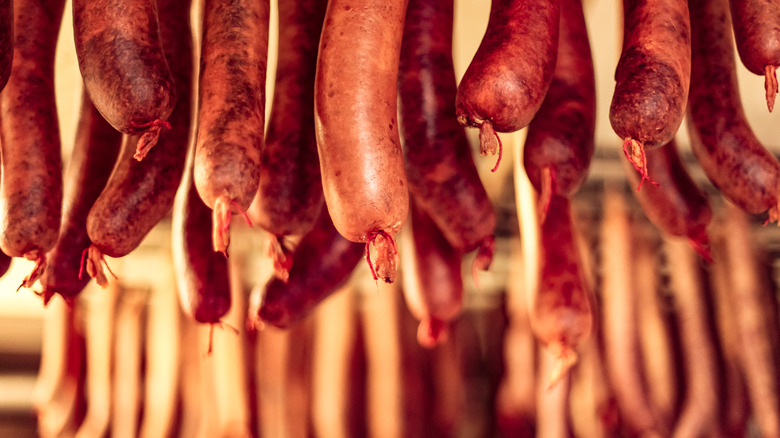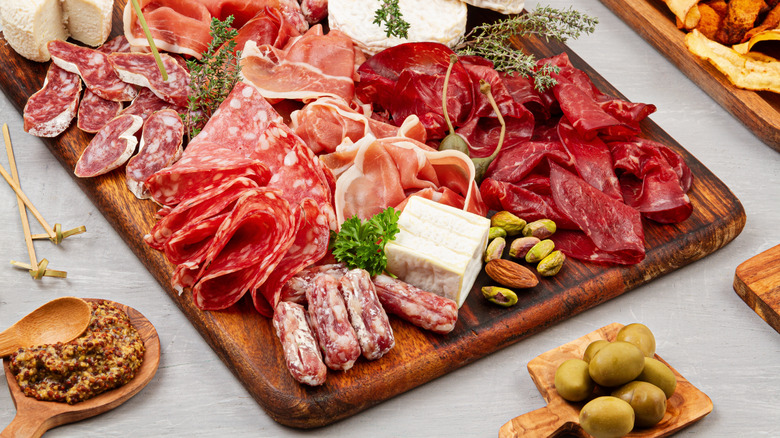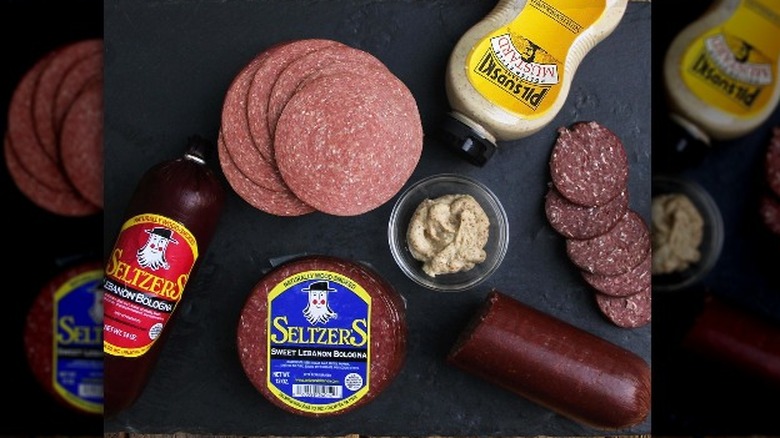Lebanon Bologna: The Smoky Sausage You Should Know About
When most people mention bologna, they typically think of the yellow containers of Oscar Mayer's oddly uniform lunch meat. But there's another bologna option available though that is a beloved staple of the Northeastern United States. According to The Takeout, Lebanon bologna is a smoked and fermented type of meat that originated in Lebanon County, Pennsylvania, just east of the state capital, Harrisburg. LebTown reports that the small town of Lebanon still celebrates the regional importance of this meat every New Year's Eve when it drops a 120-pound bologna 'chub' in the center of town.
LebTown says that Lebanon bologna is a type of semi-dry sausage that is fermented and smoked, and made from 90% lean beef and a mixture of spices. It has a dark red color that is speckled with bits of fat and may be sold in slices, chunks, or entire 'chubs' as the whole sausage roll is referred to by locals (via Taste). While there are a variety of different flavors available, one of the key features of Lebanon bologna is its tangy, smoky flavor that is derived from its processing.
The history of Lebanon bologna
According to The Baltimore Sun, documented evidence of Lebanon bologna dates as far back as the 1780s. It describes Lebanon bologna as a strange mixture of old-world and new-world traditions and preservation methods. Original recipes were a hybrid of recipes that new German settlers brought with them to Pennsylvania mixed with other sausage styles that were popular with the English colonists.
Pennsylvania Center for the Book reports that what is considered Lebanon bologna today was first crafted by the Pennsylvania Dutch population that settled in much of the Lebanon valley. The new farmers became more reliant on meat as a part of their diets and would have community-wide butchering days every Fall to process it. Because there were limited means of preservation at the time, the sausages were wrapped and hung in the attic to cure. Bacteria were unable to infect the meat thanks to the dry environment and relatively high acidity of the fermented meat.
The Baltimore Sun notes that by the 1800s Lebanon bologna would be a common market item. By the early 1900s, there were dozens of producers throughout the region, many of which are still operating today (via LebTown).
How is Lebanon bologna made
There are plenty of variations in methodology for preparing this meat. According to the Markets at Shrewsbury, Lebanon bologna should be made of all ground beef without any fillers, and sugar, salt, and spices that are most often unique to the manufacturer. Taste speculates that Seltzer's brand — one of the largest and oldest producers — uses a blend of cinnamon, clove, ginger, white pepper, and allspice.
Another key to Lebanon bologna's signature flavor is the fermentation process. The Takeout reports that to achieve this, some manufacturers will mix in potassium nitrate, while others prefer using a starter culture instead. The original reason for this fermentation process was preservation (via Pennsylvania Center for the Book). Fermenting the meat and spice mixture lowers the pH of the meat and makes it too acidic for dangerous bacteria to gain a foothold. Phoebe Young told My Fermentation that when she makes the mixture at home, she lets the meat and culture rest for ten days in a cool space before adding spices and taking the meat to the smoker.
The meat is then put into fabric casings, and hung in a smoker (via to Pennsylvania Center for the Book). Some manufacturers use modern automated smokehouses, but Seltzers still uses all wood smokehouses and keeps a constant fire going in a pit below that smokes the meats for two to three days. Smoking time can vary, however, and Young likes to let her bologna smoke for as many as five days.
What makes Lebanon bologna different from other bolognas
Lebanon bologna's fermentation and smoky flavor help it stand out from some of its predecessors and rivals. According to My Fermentation, many people credit the Italian-cured meat Mortadella as its inspiration. Price of Meat says that this classic is made with ground pork meat and a mix of spices. It also has visible cubes of pork lardo spread evenly throughout. The flavor of this meat is mostly smooth and mild with some complexity from the spices.
Then there's the classic American bologna. According to Price of Meat, this classic lunch staple is made with a mixture of pork and beef and its own blend of spices that differ between manufacturers. For the most part, it tends to be smooth in texture and mildly sweet in flavor which makes it a great kids' lunch option. It's also a great base for sandwiches that will be loaded up with other toppings a là Mason Hereford's potato chip-laden offering.
Where Lebanon bologna stands apart from these other variations is its meat and processing. My Fermentation points out that a proper Lebanon bologna should be made entirely from beef. The fermentation and smoking processes also give it much of its flavor, and make it a remarkably different final product from other similar meats. Lebanon bologna has a much more "robust" flavor thanks to its rich meat, and slow smoking process, per Price of Meat.
How to cook with Lebanon bologna
One of the great things about Lebanon bologna is that its hardy, complex flavor makes it a versatile ingredient in a variety of recipes. The Takeout says that one of the classic ways to enjoy Lebanon bologna is to spread some cream cheese across a slice of it before rolling it up and enjoying. The smooth cream cheese cuts through some of the harsher smoky elements of the meat. Crafty Cooking Mama also recommends adding cucumber slices as well for some bright freshness with the simple snack. Lebanon bologna would also be just as comfortable as an appetizer, or on a charcuterie board as any other cured meat.
Like most other meats, it also makes a great center for sandwiches. Lebanon bologna's strong flavors can help it stand up to bold condiments and toppings (via Price of Meat). Cooper Cheese recommends preparing it on rye bread with lettuce, tomato, onion, mustard, mayonnaise, and horseradish. It's also great to serve in a breakfast sandwich, like this one from Must Love Home, in place of bacon or sausage with egg and cheese.
It's worth noting that Lebanon bologna also comes in a few different flavors. Seltzer's Smokehouse in Palmyra, Pennsylvania, boasts an impressive lineup of original, sweet, double sweet (called the "candy of Lebanon bologna), sweet chipotle, and smoke 'n honey flavors. If the original isn't to your liking, be sure to sample some of the other options out there as well.
Is Lebanon bologna nutritious?
Because Lebanon bologna is made with mostly red meat it is a relatively nutrient-dense food. According to Dietz & Watson, there are about 10 grams of protein in every 2 ounces of Lebanon bologna. It also contains about 8% of the average daily value in iron, and 7 grams of fat in the same amount. Nutrition Data shows that it is also high in Vitamins B12, B6, and niacin, which is another type of vitamin B. Healthline points out that these vitamins play a variety of roles in maintaining good health and proper bodily functions.
However, since Lebanon bologna is also a cured meat, that means it contains high levels of sodium. Salt is an essential ingredient in preserving cured meats. Lebanon bologna is no different, and, according to Nutrition Data, contains about one-third of the recommended daily value of sodium in just two slices. Lebanon bologna is also considered a processed meat, which has been designated a major cancer risk by health officials. It's also made entirely of beef, and so it comes with red meat's health risks, including a higher risk of heart disease.
Where to get Lebanon bologna
Many of the largest producers of Lebanon bologna are still located in Lebanon County, but this delicious sausage is still available throughout the country. If you can't find it in your local deli, many producers also sell their bologna online as well. According to Webstaurant Store, Seltzer's Smokehouse Meats is the largest producer of Lebanon bologna in the country. Seltzer's is also one of the oldest makers, and it has been using the same methodology for 120 years. Markets at Shrewsbury also recommends buying Lebanon bologna from S.Clyde Weaver, Kunzler, and Boar's Head.
LebTown reports that Seltzer's ships its bologna to grocery stores and delis all over the country, though it still remains a local favorite as well. It says that 70% of its meats are shipped within 120 miles of its home in central Pennsylvania. According to the Pennsylvania Center for the Book, Seltzer's produces approximately 125,000 pounds of its Lebanon bologna every week.
